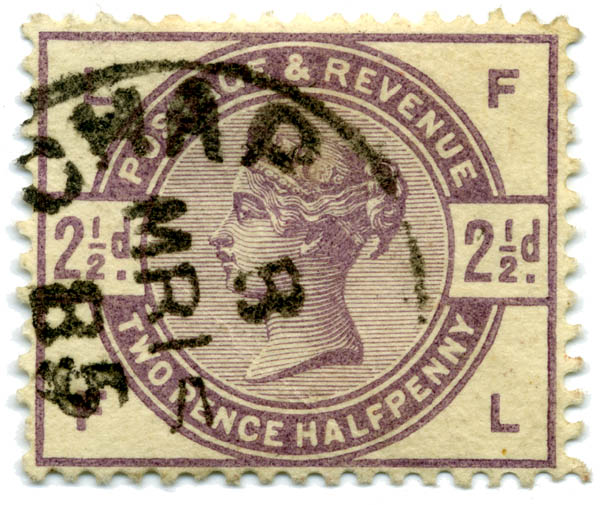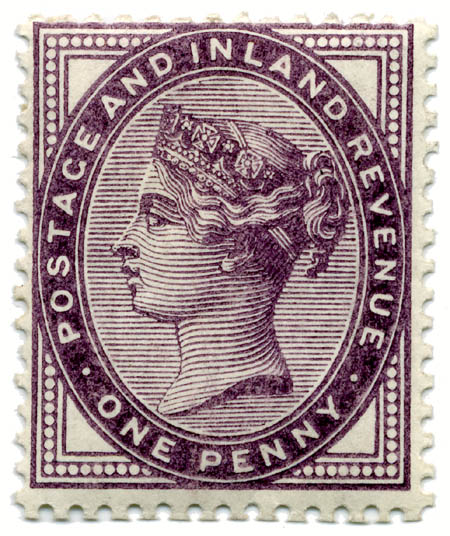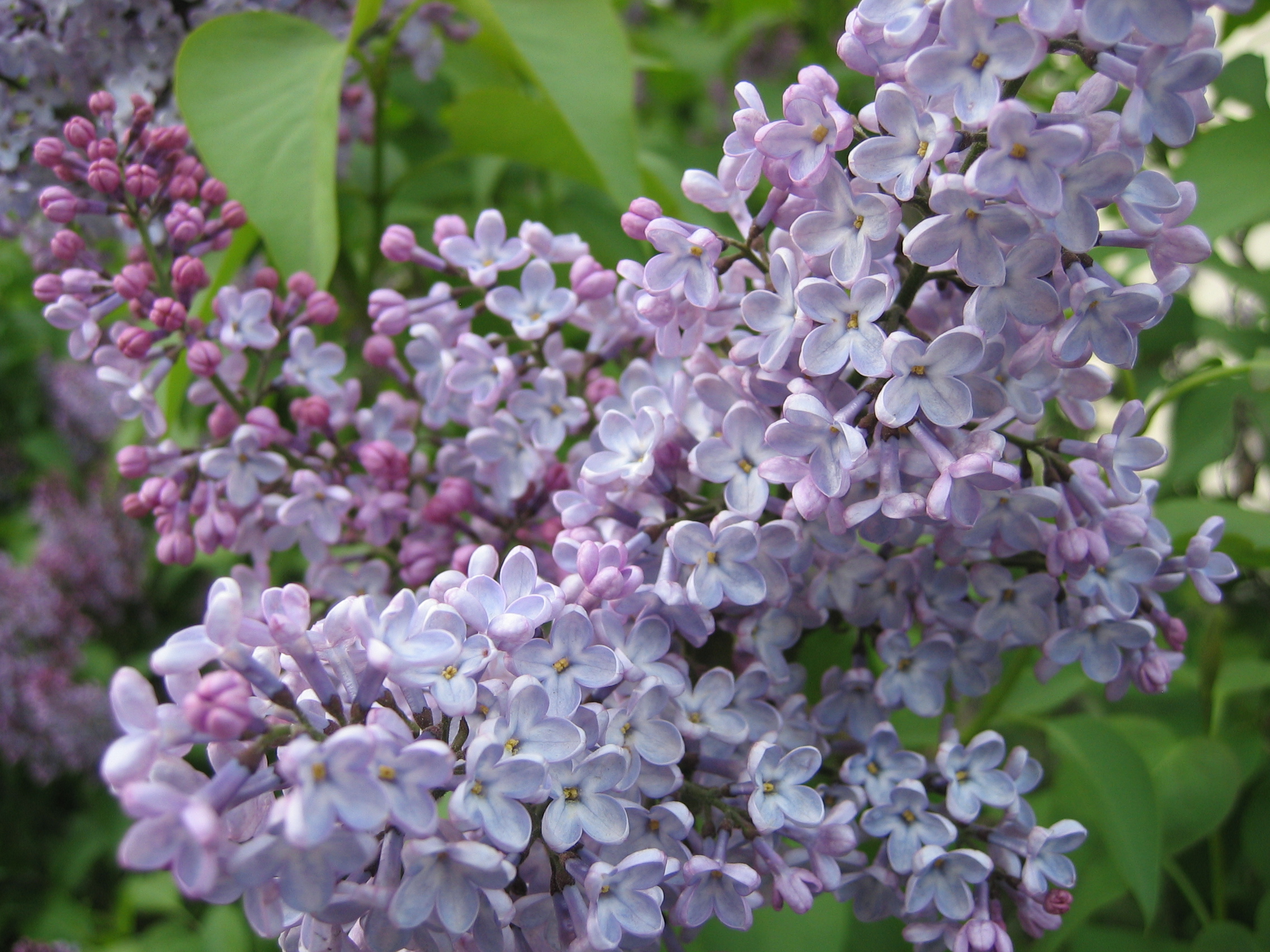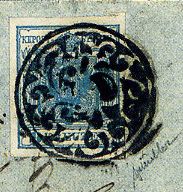|
Queen Victoria Lilac And Green Issue
The Lilac and Green issue is a series of postage and revenue stamps issued in the United Kingdom in 1883 and 1884. The stamps are known as such because they were only printed in those two colours; lilac being used for the d, 2d, d, 3d values and dull green for the 4d, 5d, 6d, 9d and 1s. New stamps were required because The Customs and Inland Revenue Act of 1881 necessitated postage stamps that were also valid as revenue stamps. Therefore, the Penny Lilac issued that year was inscribed "POSTAGE AND INLAND REVENUE" and the Lilac and Green stamps were inscribed "POSTAGE & REVENUE", whereas the previous 1880 stamps (known as the Provisional Issue) were only inscribed "POSTAGE". The colours were used because the authorities were concerned that the existing stamps were being soaked off envelopes and reused, and they wished to use fugitive inks that would wash away if immersed in water; the only fugitive ink colours available at the time were lilac and green. The first stamp to be intr ... [...More Info...] [...Related Items...] OR: [Wikipedia] [Google] [Baidu] |
Stamp UK 1884 2
Stamp or Stamps or Stamping may refer to: Official documents and related impressions * Postage stamp, used to indicate prepayment of fees for public mail * Ration stamp, indicating the right to rationed goods * Revenue stamp, used on documents to indicate payment of tax * Rubber stamp, device used to apply inked markings to objects ** Passport stamp, a rubber stamp inked impression received in one's passport upon entering or exiting a country ** National Park Passport Stamps * Food stamps, tickets used in the United States that indicate the right to benefits in the Supplemental Nutrition Assistance Program Collectibles * Trading stamp, a small paper stamp given to customers by merchants in loyalty programs that predate the modern loyalty card * Eki stamp, a free collectible rubber ink stamp found at many train stations in Japan Places * Stamp Creek, a stream in Georgia * Stamps, Arkansas People * Stamp or Apiwat Ueathavornsuk (born 1982), Thai singer-songwriter * Stamp (sur ... [...More Info...] [...Related Items...] OR: [Wikipedia] [Google] [Baidu] |
Postage And Revenue Stamp
A postage and revenue stamp, sometimes also called a dual-purpose stamp, is a stamp which is equally valid for use as a postage stamp and as a revenue stamp. They often but not always bear an inscription such as "Postage and Revenue". Dual-purpose stamps were common in the United Kingdom and the British Empire during the 19th and 20th centuries, and they are still used in some countries as of the early 21st century. Dual-purpose stamps used for postal purposes usually bear a postmark, while those which are used as revenues bear some form of fiscal cancel (such as a pen cancel, a handstamp or a commercial overprint). Use in the British Empire and Commonwealth In 1881, the Customs and Inland Revenue Act was passed in the United Kingdom, and it stated that "stamp duties of one penny may be denoted by postage stamps, and vice versa." This led to dual-purpose stamps being issued, starting with the Penny Lilac of 1881 and the Lilac and Green Issue of 1883–1884. The former ... [...More Info...] [...Related Items...] OR: [Wikipedia] [Google] [Baidu] |
United Kingdom
The United Kingdom of Great Britain and Northern Ireland, commonly known as the United Kingdom (UK) or Britain, is a country in Europe, off the north-western coast of the continental mainland. It comprises England, Scotland, Wales and Northern Ireland. The United Kingdom includes the island of Great Britain, the north-eastern part of the island of Ireland, and many smaller islands within the British Isles. Northern Ireland shares a land border with the Republic of Ireland; otherwise, the United Kingdom is surrounded by the Atlantic Ocean, the North Sea, the English Channel, the Celtic Sea and the Irish Sea. The total area of the United Kingdom is , with an estimated 2020 population of more than 67 million people. The United Kingdom has evolved from a series of annexations, unions and separations of constituent countries over several hundred years. The Treaty of Union between the Kingdom of England (which included Wales, annexed in 1542) and the Kingdom of Scotland in 170 ... [...More Info...] [...Related Items...] OR: [Wikipedia] [Google] [Baidu] |
Lilac (color)
Lilac is a color that is a pale violet tone representing the average color of most lilac flowers. The colors of some lilac flowers may be equivalent to the colors shown below as ''pale lilac'', ''rich lilac'', or ''deep lilac''. However, there are other lilac flowers that are colored red-violet. The first recorded use of ''lilac'' as an English color name was in 1775. The color "lilac" has an eponymous book published in 2018 by Coloratura Publisher. Variations Pale lilac Pale lilac is the color represented as ''lilac'' in the ISCC-NBS color list. The source of this color is sample 209 in the ISCC-NBS Dictionary of Color Names (1955). Bright lilac The color bright lilac (displayed on the right) is the color labeled ''lilac'' by Crayola in 1994 as one of the colors in its Magic Scent specialty box of colors. Rich lilac Rich lilac, a rich tone of lilac labeled ''lilac'' at Pourpre.com (a popular French color list), is shown at right. Another name for this co ... [...More Info...] [...Related Items...] OR: [Wikipedia] [Google] [Baidu] |
Green (color)
Green is the color between cyan and yellow on the visible spectrum. It is evoked by light which has a dominant wavelength of roughly 495570 nm. In subtractive color systems, used in painting and color printing, it is created by a combination of yellow and cyan; in the RGB color model, used on television and computer screens, it is one of the additive primary colors, along with red and blue, which are mixed in different combinations to create all other colors. By far the largest contributor to green in nature is chlorophyll, the chemical by which plants photosynthesize and convert sunlight into chemical energy. Many creatures have adapted to their green environments by taking on a green hue themselves as camouflage. Several minerals have a green color, including the emerald, which is colored green by its chromium content. During post-classical and early modern Europe, green was the color commonly associated with wealth, merchants, bankers, and the gentry, while red was r ... [...More Info...] [...Related Items...] OR: [Wikipedia] [Google] [Baidu] |
Penny Lilac
A penny is a coin ( pennies) or a unit of currency (pl. pence) in various countries. Borrowed from the Carolingian denarius (hence its former abbreviation d.), it is usually the smallest denomination within a currency system. Presently, it is the formal name of the British penny ( p) and the ''de facto'' name of the American one-cent coin (abbr. ¢) as well as the informal Irish designation of the 1 cent euro coin (abbr. c). It is the informal name of the cent unit of account in Canada, although one-cent coins are no longer minted there. The name is used in reference to various historical currencies, also derived from the Carolingian system, such as the French denier and the German pfennig. It may also be informally used to refer to any similar smallest-denomination coin, such as the euro cent or Chinese fen. The Carolingian penny was originally a 0.940-fine silver coin, weighing pound. It was adopted by Offa of Mercia and other English kings and re ... [...More Info...] [...Related Items...] OR: [Wikipedia] [Google] [Baidu] |
Postage Stamp Reuse
Postage stamp reuse is the technique of fraudulently reusing postage stamps from sent mail to avoid paying the cost of postage. Reuse A postage stamp is a small piece of paper attached to mail that indicates that the postage (the cost of sending the mail) has been paid. Because stamps are sent on most mail, the stamp on a received item can be removed and placed on a different piece of mail to be sent, thus reusing the stamp without paying the proper postage. In many countries, such as the United States, reuse of used stamps, whether cancelled or not, is illegal. Prevention Mute cancellation (''killer'') After use, many stamps are marked by a cancellation by the postal system, which defaces the stamp and prevents its reuse. The cancellation usually includes a killer placed on the stamp that has black bars, cork impressions or other obstructive shapes to deface the stamp. Instead of using an entirely separate mark, some countries use their postmark, placed on the stamp, to ca ... [...More Info...] [...Related Items...] OR: [Wikipedia] [Google] [Baidu] |
Fugitive Pigments
Fugitive pigments are impermanent pigments that lighten, darken, or otherwise change in appearance or physicality over time when exposed to environmental conditions, such as light, temperature, humidity, or pollution. Fugitive pigments are present in types of paint, markers, inks etc., which are used for temporary applications. Fugitive inks which washed away when soaked in water were sometimes used deliberately to prevent postage stamps being removed from envelopes by soaking, and reused (e.g., the Queen Victoria Lilac and Green Issue). While permanent pigments are usually used for painting Painting is the practice of applying paint, pigment, color or other medium to a solid surface (called the "matrix" or "support"). The medium is commonly applied to the base with a brush, but other implements, such as knives, sponges, and ...s, painters have made work wholly or partially with fugitive pigments for a number of reasons: availability and cost of pigments; being more ... [...More Info...] [...Related Items...] OR: [Wikipedia] [Google] [Baidu] |
Queen Victoria
Victoria (Alexandrina Victoria; 24 May 1819 – 22 January 1901) was Queen of the United Kingdom of Great Britain and Ireland from 20 June 1837 until Death and state funeral of Queen Victoria, her death in 1901. Her reign of 63 years and 216 days was longer than that of List of monarchs in Britain by length of reign, any previous British monarch and is known as the Victorian era. It was a period of industrial, political, scientific, and military change within the United Kingdom, and was marked by a great expansion of the British Empire. In 1876, the British Parliament voted to grant her the additional title of Empress of India. Victoria was the daughter of Prince Edward, Duke of Kent and Strathearn (the fourth son of King George III), and Princess Victoria of Saxe-Coburg-Saalfeld. After the deaths of her father and grandfather in 1820, she was Kensington System, raised under close supervision by her mother and her comptroller, John Conroy. She inherited the throne aged 18 af ... [...More Info...] [...Related Items...] OR: [Wikipedia] [Google] [Baidu] |
Jubilee Issue
The postage and revenue stamps of the United Kingdom issued in 1887 are known as the "Jubilee" issue because they were issued during the year of the Golden Jubilee of the accession of Queen Victoria to the throne in 1837. They continued in use throughout the remainder of Victoria's reign, and many of the designs were reused in the stamps of Edward VII. The Jubilee issue includes the first British stamps to be printed in two colours. Origins The variety of colours and designs was partly in response to the much-disliked " Lilac and Green" issues of 1883-1884. The 1884 Stamp Committee was formed to make decisions about improved replacements. After several meetings, and considering a number of essays by De La Rue (many of which survive in the marketplace), they produced a report recommending the use of surface printing, two colours in fugitive inks, coloured paper, and the dropping of the corner letters that had distinguished stamps on the sheet. Issue The 1887 issue generally fol ... [...More Info...] [...Related Items...] OR: [Wikipedia] [Google] [Baidu] |
Stanley Gibbons
The Stanley Gibbons Group plc is a company quoted on the London Stock Exchange specialising in the retailing of collectable postage stamps and similar products. The group is incorporated in London. The company is a major stamp dealer and philatelic publisher. The company's philatelic subsidiary, Stanley Gibbons Limited, has a royal warrant of appointment from Queen Elizabeth II. History The company has a long corporate history, having started as a sole trader business owned by Edward Stanley Gibbons in 1856 and now being a quoted company with a number of subsidiaries. Before 1900 The business started when, employed as an assistant in his father's pharmacy shop in Plymouth, Gibbons set up a counter selling stamps. In 1863 he was fortunate enough to purchase from two sailors a sackful of rare Cape of Good Hope triangular stamps. In 1874 Gibbons moved to a house near Clapham Common in South London and in 1876 he moved again to Gower Street in Bloomsbury near the British Mu ... [...More Info...] [...Related Items...] OR: [Wikipedia] [Google] [Baidu] |
Philatelists
Philately (; ) is the study of postage stamps and postal history. It also refers to the collection and appreciation of stamps and other philatelic products. Philately involves more than just stamp collecting or the study of postage; it is possible to be a philatelist without owning any stamps. For instance, the stamps being studied may be very rare or reside only in museums. Etymology The word "philately" is the English transliteration of the French "", coined by Georges Herpin in 1864. Herpin stated that stamps had been collected and studied for the previous six or seven years and a better name was required for the new hobby than ''timbromanie'' (roughly "stamp quest"), which was disliked.Williams, L.N. & M. ''Fundamentals of Philately''. State College: The American Philatelic Society, 1971, p.20. The alternative terms "timbromania", "timbrophily", and "timbrology" gradually fell out of use as ''philately'' gained acceptance during the 1860s. Herpin took the Greek root word Ď ... [...More Info...] [...Related Items...] OR: [Wikipedia] [Google] [Baidu] |




.jpg)



